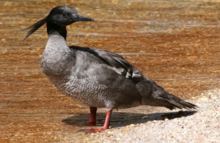Mergus octosetaceus
| Brazilian merganser | |
|---|---|
 |
|
| Scientific classification | |
| Kingdom: | Animalia |
| Phylum: | Chordata |
| Class: | Aves |
| Order: | Anseriformes |
| Family: | Anatidae |
| Genus: | Mergus |
| Species: | M. octosetaceus |
| Binomial name | |
|
Mergus octosetaceus Vieillot, 1817 |
|
The Brazilian merganser (Mergus octosetaceus) is a duck in the typical merganser genus. It is one of the six most threatened waterfowl in the world with possibly fewer than 250 birds in the wild and currently 4 kept in captivity at 2 different Brazilian locations. The origin of its name is from its long, sharp-edged beak that has a great number of teeth-looking edges.
This merganser is a dark, slender duck with a shiny dark-green hood with a long crest, which is usually shorter and more worn-looking in females. Upperparts are dark grey while the breast is light grey, getting paler toward the whitish belly, and a white wing patch is particularly noticeable in flight. It has a long thin jagged black bill with red feet and legs. Although females are smaller with a shorter bill and crest, both sexes are alike in color. The slender ducks range in size from 49 centimeters to 56 centimeters as an adult. Young Brazilian mergansers are mainly black with white throat and breast.
The Brazilian mergansers are generally silent birds, but may make barking calls in certain situations. Four calls have been recorded. A harsh krack-krack acts as an alarm call emitted in flight. Males make a barking dog-like call, females make a harsh rrr-rrrr and the contact call ia a soft rak-rak-rak. Ducklings give a high pitched ik-ik-ik.
Depending on the availability of suitable nesting and feeding sites, Brazilian merganser pairs occupy permanent territories of eight to seventeen kilometer stretches of rivers. Tree cavities, rock crevices, or disused burrows predominantly made by armadillos are the ideal places for these mergansers to build their nests. It is thought the breeding season is during the austral winter, when rain is minimal and water levels are low, but it may vary geographically. The Brazilian merganser usually lays three to six eggs in June and July, with the chicks hatching during the following July and August. The young are capable of flight by September and/or October. Only the female birds incubate the eggs, but both parents care for the young. This is a very unusual behavior in ducks for both parents to help raise the young birds including direct provision of food to young. Adult Brazilian mergansers are believed to remain on the same territory all year round, but there is not very much information about their movements and dispersal, so information on this is presently speculative in nature.
...
Wikipedia

